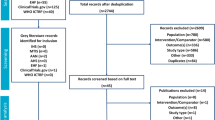Abstract
Seven oral triptans, which differ on a range of attributes important for treatment selection, are now available for treating migraine. US neurologists were surveyed to assess the relative importance of treatment attributes, prespecified by clinical relevance and availability of controlled study data, for selecting among oral triptans. Using a multiattribute decision model, we combined these data on the importance of treatment attributes with information on the relative performance of the oral triptans derived from a recent meta-analysis of controlled clinical trials.
Similar content being viewed by others
References and Recommended Reading
Lipton RB, Stewart WF, Diamond S, et al.: Prevalence and burden of migraine in the United States: data from the American Migraine Study II. Headache 2001, 41:646–657.
Menken M, Munsat TL, Toole JF: The global burden of disease study: implications for neurology. Arch Neurol Mar 2000, 57:418–420.
Goadsby PJ, Lipton RB, Ferrari MD: Migraine: current understanding and treatment. N Engl J Med 2002, 346:257–270.
Lipton RB, Stewart WF: Acute migraine therapy: Do doctors understand what patients with migraine want from therapy? Headache 1999, 39(suppl 2):S20-S26.
Davies GM, Santanello N, Lipton R: Determinants of patient satisfaction with migraine therapy. Cephalalgia 2000, 20:554–560.
Gallagher RM, Kunkel R: Migraine medication attributes important for patient compliance: concerns about side effects may delay treatment. Headache 2003, 43:36–44.
Lipton RB, Stewart WF, Simon D: Medical consultation for migraine: results form the American Migraine Study. Headache 1998, 38:87–96.
Ferrari MD, Roon KI, Lipton RB, Goadsby PJ: Oral triptans (serotonin 5-HT1B/1D agonists) in acute migraine treatment: a meta-analysis of 53 trials. Lancet 2001, 358:1668–1675.
Ferrari MD, Goadsby PJ, Roon KI, Lipton RB: Triptans (serotonin, 5-HT1B/1D agonists) in migraine: detailed results and methods of a meta-analysis of 53 trials. Cephalalgia 2002, 22:633–658. Important study.
Silberstein SD: Practice parameter: evidence-based guidelines for migraine headache (an evidence-based review). Report of the Quality Standards Subcommittee of the American Academy of Neurology. Neurology 2000, 55:754–762.
Goadsby PJ: The pharmacology of headache. Prog Neurobiol 2000, 62:509–525.
von Winterfeldt D, Edwards W: Decision Analysis and Behavioral Research. Cambridge: Cambridge University Press; 1987.
Dolan JG: Medical decision-making using the analytic hierarchy process: choice of initial antimicrobial therapy for acute pyelonephritis. Med Decis Making 1989, 9:51–56.
Barriere SL: Formulary evaluation of second-generation cephamycin derivatives using decision analysis. Am J Hosp Pharm 1991, 48:2146–2150.
Schumacher GE: Multiattribute evaluation in formulary decision-making as applied to calcium-channel blockers. Am J Hosp Pharm 1991, 48:301–308.
Eriksen S, Keller LR: A multiattribute-utility-function approach to weighing the risks and benefits of pharmaceutical agents. Med Decis Making 1993, 13:118–125.
Dolan JG, Bordley DR: Isoniazid prophylaxis: the importance of individual values. Med Decis Making 1994, 14:1–8.
Brodie MJ, Kwan P: The Star Systems: overview and use in determining antiepileptic drug choice. CNS Drugs 2001, 15:1–12.
American Medical Association: Physician Characteristics and Distribution in the US. Chicago: American Medical Association; 2001.
Health Resources and Services Administration: Bureau of Health Professions. State health workforce profiles. http://bhpr.hrsa.gov/healthworkforce/profiles/default.htm. Accessed January 14, 2003.
Saaty TL: How to make a decision: the analytic hierarchy process. Interfaces 1994, 24:19–43.
Dolan JG, Isselhardt BJ Jr, Cappuccio JD: The analytic hierarchy process in medical decision making: a tutorial. Med Decis Making 1989, 9:40–50.
Mooney CZ, Duval RD: Bootstrapping: A Nonparametric Approach to Statistical Interference. Newbury Park, CA: Sage Publications; 1993.
Hwang CL, Yoon KP: Multiattribute Decision-Making: Methods and Applications. Berlin: Springer; 1981.
Yoon KP, Hwang CL: Multiple Attribute Decision-Making: An Introduction. Thousand Oaks, CA: Sage; 1995.
Deng H, Yeh C-H, Willis RJ: Inter-company comparison using modified TOPSIS with objective weights. Comput Oper Res 2000, 27:963–973.
Azar F: Multiattribute decision-making: use of three scoring methods to compare the performance of imaging techniques for breast cancer detection. http://www.seas.upenn.edu/be/Tech_Reports/fredazar_rechreport_MS_BE_00_01.PDF. Accessed October 21, 2002.
Zeleny M: Multiple Criteria Decision Making. New York: McGraw Hill; 1982.
Roon KI, Lipton R, Goadsby PJ, Ferrari M: Placebo in triptan trials: efficacy, tolerability, and consistency. Cephalalgia 2001, 21:405–432.
Baltussen RM, Hutubessy RC, Evans DB, Murray CJ: Uncertainty in cost-effectiveness analyses: probabilistic uncertainty analysis and stochastic league tables. In GPE Discussion Paper Series: No 34. Geneva World Health Organization. www nt.who.int/whosis/statistics/discussion_papers/pdf/paper34pdf. Accessed November 2003.
Brodie MJ: Monostars: an aid to choosing an antiepileptic drug as monotherapy. Epilepsia 1999, 40(suppl 6): S17-S22; discussion, S73–S74.
Crawford PM, Pope S. The Star Systems. CNS Drugs 2001, 15:13–15.
Cutrer FM, Goadsby PJ, Ferrari M, et al.: Prioritization of treatment attributes in selecting an oral triptan: a survey of U.S. primary care physicians. Headache 2002, 42:392–393.
Lipton RB, Liberman J, Goadsby PJ, et al.: An assessment of the priorities of US migraineurs with respect to prespecified triptan treatment attributes. Headache 2002, 42:394–395.
Dodick DW, Lipton RB, Goadsby PJ, et al.: Prioritizing triptan treatment attributes: a pilot study. Neurology 2002, 58(suppl 3):A129.
McCrory D: Selecting the preferred triptans. Cephalalgia 2002, 22:575–576. Noteworthy study.
Lipton RB, Bigal ME, Rush SR, et al.: Migraine practice patterns among neurologists. Neurology 2004, 62:1926–1931.
Moss L, Goldstein H: The Recall Method in Social Surveys. London: University of London Institute of Education; 1979.
Abi-Zeid I, Belanger M, Guitouni A, et al.: A Multicriteria Method for Evaluating Courses of Action in Canadian Airspace Violation Situations. http://www.dodccrp.org/Proceedings/DOCS/wcd00000/wcd00091.htm, 2002. Accessed November 2003.
Trowbridge R, Weingarten S: Clinical decision support systems. Chapter 53 in Evidence Report/Technology Assessment no 43, Making Health Care Safer: a Critical Analysis of Patient Safety Practices. Agency for Healthcare Research and Quality, Washington. http://www.ahcpr.gov/clinic/ptsafety/chap53.htm, 2001. Accessed November 2003.
Purdy RA: Evidence-based migraine therapy: learning needs and knowledge assessment. Cephalalgia 2000, 20(suppl 2):5–9.
Author information
Authors and Affiliations
Rights and permissions
About this article
Cite this article
Dodick, D.W., Lipton, R.B., Ferrari, M.D. et al. Prioritizing treatment attributes and their impact on selecting an oral triptan: Results from the TRIPSTAR project. Current Science Inc 8, 435–442 (2004). https://doi.org/10.1007/s11916-004-0064-2
Issue Date:
DOI: https://doi.org/10.1007/s11916-004-0064-2




